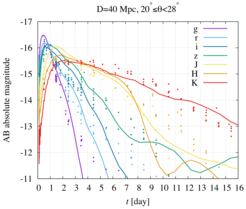A radiative transfer simulation for the GW170817 kilonova
Study shows how consistently taking into account the interplay of ejecta components naturally reproduces observed lightcurves and photospheric velocity
Binary neutron star mergers like the recently observed GW170817 with its electromagnetic counterparts provide valuable opportunities to test theoretical models of these events. Here, an axisymmetric radiative transfer simulation for kilonovae/macronovae is performed, that takes into account the non-trivial radiation transfer of photons between multiple ejecta components of non-spherical morphology. The observed optical and infrared lightcurves can be reproduced by our model that agrees quantitatively with the prediction of numerical-relativity simulations.
Paper abstract

Recent detection of gravitational waves from a binary neutron star merger (GW170817) and the subsequent observations of electromagnetic counterparts provide a great opportunity to study the physics of compact binary mergers. The optical and near-infrared counterparts to GW170817 (SSS17a, also known as AT 2017gfo or DLT17ck) are found to be consistent with a kilonova/macronova scenario with red and blue components. However, in most previous studies wherein the contribution from each ejecta component to the lightcurves is separately calculated and composited, the red component is too massive of a dynamical ejecta, and the blue component is too fast of a post-merger ejecta. In this Letter, we perform a two-dimensional radiative transfer simulation for a kilonova/macronova, consistently taking the interplay of multiple ejecta components into account. We show that the lightcurves and photospheric velocity of SSS17a can be reproduced naturally by a setup that is consistent with the prediction of the numerical-relativity simulations.












